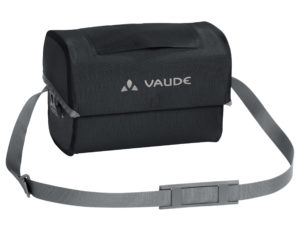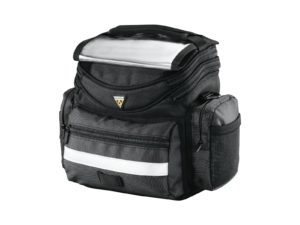Waterproof vs Pockets
As explained on the website, there are 2 types of traditional bicycle panniers: those we have called “trekking” which are waterproof and “touring” which are not but which have the particularity of being better compartmentalised and therefore more practical.
This is due to their design. Each pocket adds an additional seam or zip that could let in water. So what you get is either a practical pannier made of a Cordura style fabric with many pockets and other features but for which you will need a rain cover to ensure its waterproofness, OR a simpler, waterproof bag made of a tarpaulin style material and looking like a large “big bag” inside which you will have to organize.

Waterproof handlebar bag, without external pockets

Handlebar bag not waterproof but with many pockets.
There are arguments in both directions that can tip the balance in the direction of the waterproofness or the pockets side.
First of all, the waterproofness of a bag has its limits in the sense that it is not eternal. During the first weeks or months of use, no problem, the waterproofness is guaranteed. However, it is important to know that moisture does not need large holes to penetrate inside the bag. Some small “pinprick” holes that you are not aware of, are enough for water to penetrate by capillary action. The apparition of these micro-holes is inevitable during a trip: each time the bike falls (unbalance of the parked bike), each time you put it against a rough wall, each time you hit a border a little too high, a root or a branch, the bag suffers and loses a little of its waterproofness. Let’s get this straight, even after a heavy rain you won’t have 1 cm of water in the bag’s bottom but you could find your wet effects.
On the other hand, it is pleasant to have the opportunity to store your belongings in the bags knowing that you will find them dry at the end of the day, without having to take out your rain cover at the slightest rainfall. But clearly, most cyclists do not go on trips of several months. So if you use your bags a few weeks a year while taking care of them, they should remain waterproof for several years.
Moreover, it should not be denied that having storage pockets is also pleasant. What a comfort not to have to open the bag completely and to take out half of its contents to reach any accessory.
So, what to choose? The waterproofness or the pockets?
My opinion, which only engages me, is based on my personal experience (if we put my various trips together we should reach nearly 2 years of travelling on a bicycle).
I think that for a long trip over several months it is still better to opt for waterproof bags (“trekking”) because even if, in the long run, they will lose their waterproofness, they will always be easier to maintain (with a sponge and a little water). In case of a large hole or tear, it is not impossible to repair (“Seam Grip”, also works for the tent, raincoats…). This loss of waterproofness is not a legend, I can talk about it (I mainly used Ortlieb). My personal experience has shown me that this phenomenon mainly concerns side bags, those coming on the top of the rackpack (rackpack) and the handlebar bags seem to escape. However, I always protect my sleeping bags and mattresses in dry bags before storing them in the side panniers.
I must also admit that the incessant searches necessary to find the slightest object have consumed a good dose of my mental energy each time. Moreover I must admit that it is my wife, much more ordered than myself, who usually takes care of the storage in the bags… A few well-placed pockets would have helped us…
For shorter trips, traveling with bags with pockets, so not waterproof, makes sense.
Finally, I would say: do as you like, according to your personal style preference but with full knowledge of the facts!


